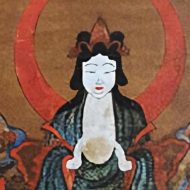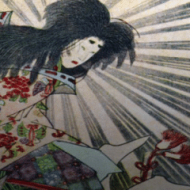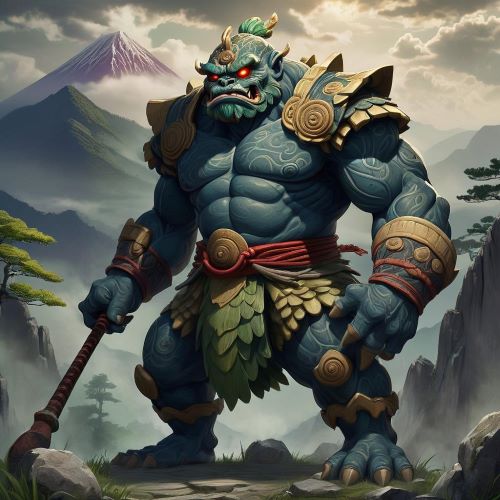Tsukuyomi : The Moon God
Listen
Tsukuyomi
Introduction
Tsukuyomi, often referred to as Tsukuyomi-no-Mikoto, is one of the most significant deities in Japanese mythology, representing the moon. As a central figure in Shinto belief, Tsukuyomi is revered for embodying the calm, serene, and sometimes mysterious nature of the night. His story is deeply tied to the creation myths of Japan, as he is one of the three noble children born from the cleansing ritual of the god Izanagi after his harrowing journey to Yomi, the land of the dead.
Unlike many mythological moon gods worldwide who are often female, Tsukuyomi is male. This unique aspect adds depth to his character and provides an interesting cultural contrast, especially in relation to his divine siblings — Amaterasu, the radiant sun goddess, and Susanoo, the stormy sea god. Together, they form one of the most powerful triads in Japanese mythology, shaping the balance of nature and divine order.
Physical Traits
The moon deity Tsukuyomi is rarely given detailed physical descriptions in the ancient texts, but his essence is closely tied to the luminous, ethereal quality of the moon itself. While the moon in Japanese culture is often a subject of beauty and admiration, Tsukuyomi’s mythological reputation carries a darker undertone, setting him apart from purely benevolent deities.
He is sometimes envisioned as a noble figure draped in courtly garments, his face pale and radiant like moonlight over still water. Yet his expression, unlike that of his sister Amaterasu, is often imagined as cool, serene, and unyielding—reflecting his unbending commitment to order. Artists and storytellers over the centuries have portrayed him with an elegance befitting a celestial god, but always tinged with the gravity of one who makes difficult, irreversible decisions.
Family
Tsukuyomi’s origins lie in one of the most famous episodes of Shinto creation mythology. He is the son of Izanagi, the creator god, born during a sacred cleansing ritual known as misogi. After Izanagi’s perilous journey to Yomi—the Land of the Dead—to retrieve his wife Izanami ended in failure, he returned to the living world tainted by the impurities of death. Izanami had eaten the food of the underworld, binding her there for eternity, and so Izanagi could not bring her back.
To purify himself, Izanagi washed away the pollution of Yomi in a ritual ablution. From this act, three divine children emerged: from his left eye came Amaterasu, goddess of the sun; from his right eye came Tsukuyomi, god of the moon; and from his nose came Susanoo, god of storms and the sea. These three would be known as the “Three Precious Children” (Mihashira-no-Uzunomiko) and were given rulership over the heavens, seas, and celestial cycles.
Some traditions claim that Tsukuyomi and Amaterasu were married before their eventual estrangement. Other interpretations suggest they were always separate but complementary forces—day and night, light and shadow. A few later stories even hint that Tsukuyomi might have fathered children with Amaterasu, possibly linking him to the origins of the Japanese imperial line, though such claims remain rare and disputed.
Other Names
Tsukuyomi is known by several variations of his name, depending on the source or period of the text. The most common form, Tsukuyomi-no-Mikoto, translates roughly to “Moon Reader” or “Moon Ruler.” Some interpretations suggest that “yomi” in his name refers to counting time, reflecting the moon’s role in marking months and seasons in ancient Japan. In other cases, “yomi” is linked to the underworld, hinting at a more mystical or even ominous connection between the moon and death.
Powers and Abilities
As the moon god, Tsukuyomi holds dominion over the night sky, controlling the cycles of the moon and influencing the passage of time. In ancient Japan, the lunar calendar played a central role in agriculture, festivals, and religious ceremonies, making Tsukuyomi an important figure in maintaining the natural and societal order.
One of the most famous myths involving Tsukuyomi highlights his unwavering sense of justice. When he attended a feast hosted by Ukemochi, the goddess of food, he was horrified to see her create a meal by producing food from her body. Viewing this as deeply impure, Tsukuyomi killed her on the spot. This act enraged Amaterasu, who vowed never to look at him again, creating the eternal separation between the sun and moon.
Though this story paints Tsukuyomi as stern and uncompromising, it also shows his commitment to purity and divine order — values deeply rooted in Shinto belief.
Modern Day Influence
Tsukuyomi’s legacy continues to shine brightly in modern Japanese culture and beyond. He frequently appears in literature, anime, video games, and even pop culture references worldwide. In Japanese media, Tsukuyomi is often reimagined as a mysterious or noble figure, sometimes as a hero and other times as a morally complex character whose actions challenge the audience’s perception of right and wrong.
His name has been adopted in various contexts — from manga titles to special abilities in video games and anime, such as the “Tsukuyomi” illusion technique in Naruto. Even in astronomy and creative works, the moon’s symbolism in connection to Tsukuyomi remains powerful, representing balance, mystery, and the unseen truths that lie beneath the surface.
In Shinto practices, Tsukuyomi is still honored at certain shrines across Japan, often as part of broader worship alongside his sister Amaterasu. His enduring influence reflects the timeless fascination with the moon’s quiet power and its role in marking the rhythms of life.
Related Images
Sources
Britannica. (n.d.). Tsukuyomi—Shintō deity. In Britannica.com. Retrieved August 9, 2025, from https://www.britannica.com/topic/Tsukiyomi
Wikipedia Contributors. (2025, July). Tsukuyomi-no-Mikoto. In Wikipedia. Retrieved August 9, 2025, from https://en.wikipedia.org/wiki/Tsukuyomi-no-Mikoto
Wikipedia Contributors. (2025, July). Amaterasu. In Wikipedia. Retrieved August 9, 2025, from https://en.wikipedia.org/wiki/Amaterasu
Centre of Excellence. (2025, June). Tsukuyomi in Japanese Mythology: Myths, Symbols & Powers. Retrieved from https://www.centreofexcellence.com/tsukuyomi-in-japanese-mythology/
Britannica Contributors. (n.d.). Ukemochi no Kami. In Britannica.com. Retrieved August 9, 2025, from https://www.britannica.com/topic/Ukemochi-no-Kami
Wikipedia Contributors. (2025, May). Ukemochi. In Wikipedia. Retrieved August 9, 2025, from https://en.wikipedia.org/wiki/Ukemochi
Wikipedia Contributors. (2025, July). Izanagi. In Wikipedia. Retrieved August 9, 2025, from https://en.wikipedia.org/wiki/Izanagi
Wikipedia Contributors. (2025, May). Gassan Shrine. In Wikipedia. Retrieved August 9, 2025, from https://en.wikipedia.org/wiki/Gassan_Shrine
Frequently Asked Questions
Who is Tsukuyomi?
Tsukuyomi is the Shinto deity of the moon, born from Izanagi’s right eye during ritual purification. He presides over the night and maintains cosmic balance with his siblings.
What is the myth of Tsukuyomi and Ukemochi?
Tsukuyomi killed the food goddess Ukemochi after being disgusted by how she prepared food—prompting Amaterasu to reject him and symbolically separating day and night.
Why is Tsukuyomi associated with purity and order?
Though myths don’t explicitly state it, his extreme reaction in the Ukemochi myth reflects Shinto values of ritual cleanliness and decorum.
Are Tsukuyomi and Amaterasu married?
Some later interpretations refer to them as consorts, but classical texts like the Kojiki and Nihon Shoki do not describe a marital relationship—only a divine sibling bond.
How is Tsukuyomi honored today?
Shrines such as Gassan Shrine in Yamagata are dedicated to Tsukuyomi-no-Mikoto. He’s also remembered culturally in moon-viewing rituals and creative works across media.
Watch
I am raw html block.
Click edit button to change this html














